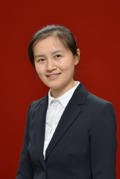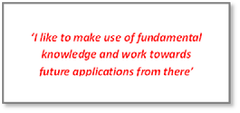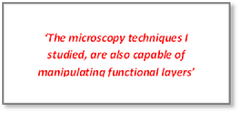 Self-assembled monolayers (SAMs) have a great potential to be used in molecular electronic devices such as diodes, transistors and switches. The techniques to study the dynamics of these layers however are limited, says Hairong Wu. ‘The efforts in this thesis to monitor the dynamics of SAMs from a true molecular perspective, were achieved by time-resolved scanning tunnelling microscopy (TR STM),’ she says.
Self-assembled monolayers (SAMs) have a great potential to be used in molecular electronic devices such as diodes, transistors and switches. The techniques to study the dynamics of these layers however are limited, says Hairong Wu. ‘The efforts in this thesis to monitor the dynamics of SAMs from a true molecular perspective, were achieved by time-resolved scanning tunnelling microscopy (TR STM),’ she says.
By using in-situ electrochemical atomic force microscopy (EC-AFM ) - in the recently developed peak force tapping mode - redox active protein layers were also imaged. The results show these scanning probe microscopy techniques are ready to be applied in a wide range of research fields.
The dynamics of decanethiol SAMs studied by TR STM, was the first breakthrough moment in Hairong Wu’s PhD-project. ‘We were able to image the dynamics of the monolayers for 24 hours, without interrupting the sample at all,’ she says. ‘Recording current-time spectroscopy for various areas on the SAM surface, enables further understanding of the mechanisms of the dynamics on these surfaces.’
Scanning probe microscopy techniques

Hairong believes TR STM, together with in situ EC-AFM, are about to become an important ‘family of techniques’ to study a wide range of scientific questions in which organic molecular layers and catalytic reactions are involved. ‘My thesis work was fundamental by nature,’ Hairong says, adding: ‘The remarkable results are a strong indication in the way future applications and devices will be studied. The microscopy techniques I studied, are also capable of manipulating functional layers and quantify properties, for instance activation energies. I am sure these techniques will play a key-role in the future.’
Multidisciplinary

Experimental work was at the center of Hairong’s approach, physics and chemistry playing equally important roles as this thesis was a joined project of the groups: Physics of Interfaces and Nanomaterials (PIN) and Materials Science and Technology of Polymers (MTP).
Hairong: ‘This collaboration was intended right from the start, as multiple disciplines are requisite to make progress here. For me it was a great opportunity to come here and deepen my knowledge, at the same time learning various novel lab skills and getting to learn materials, equipment and sample preparation methods on a nano scale.
‘My lab was next to the cleanroom and I collaborated with a lot of Mesa+ experts, scientists and technicians alike. Easy contacting colleagues and the always present willingness to be helpful and to share knowledge, is one of the main good points of the Mesa+ Institute.’
About future

When thinking about her future career, Hairong welcomes the idea to go and work in a research group that is closer to the real applications, being able to see her work actually leading to real applications one day. ‘Altogether, staying in fundamental research area also appeals to me,’ she says. ‘I like to make use of fundamental knowledge and work towards future applications from there.’
